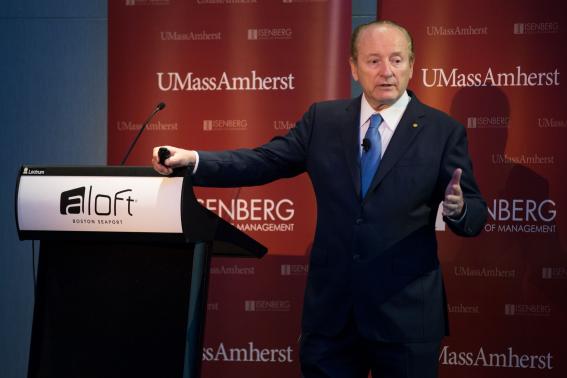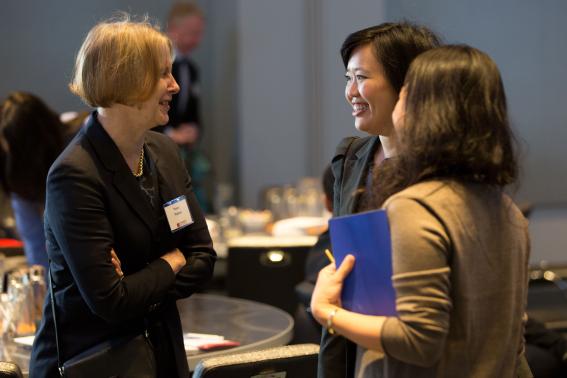Nobelist in Economics Headlines Annual CISDM Event
October 23, 2017
Since the 1970s, innovation—conceptual and technological—has transformed the practice of finance. But “innovation itself doesn’t create growth” . . . it must be “translated into the general economy,” insisted MIT finance professor Robert C. Merton in his keynote presentation at Isenberg’s Center for International Securities and Derivatives Markets’ (CISDM) annual research conference on October 6. Professor Merton—a 1997 recipient of the Nobel Prize in Economics—headlined an ambitious program devoted to diverse aspects of digitally enabled financial innovation, including cryptocurrencies, algorithmic trading, and other advances on the financial landscape. Attended by a packed house of 125 academics and practitioners, the daylong event took place at Boston’s Aloft Boston Seaport Hotel.

In his dual role as keynoter and elder statesman, Merton placed current innovations in historical perspective, while making an irrefutable case for finance’s status as a science. Finance passes muster, he said, because it offers “an organized structure of theories and hypotheses that can be rejected [i.e., falsified] and that makes serious attempts [to employ] data in a structured form.” Moreover, “the most advanced research actually gets used in the main stream. That’s rather uncommon!” exclaimed Merton, who earned the Nobel Prize for his innovations in the valuation of derivatives.
Finance, Merton continued, “is not a side show.” Main Street versus Wall Street is a false dichotomy. “The financial system and the real economy are inextricably linked. The discipline, Merton continued, deploys technological resources in the right places; “. . . it puts the risks in the right places. It’s all about risk, [which is itself] an intangible.”
Transition and Transformation. Merton characterized financial theory and practice before the 1950s as prescientific, grounded largely on anecdotes with “basically no data.” Next, he took his audience on a tour of innovations in the 1950s through the 1970s. It was during the 1970s that momentous risks like the first oil crisis, double-digit inflation, and realignment of the currency system after the fall of Breton Woods spawned “an extraordinary explosion of financial innovation,” he remarked. The creative responses—options exchanges, financial futures for currencies, index funds, debt securitization, worldwide derivatives markets, and other innovations, he said, “have been producing societal dividends for decades.”
“Boy, did I get lucky,” mused Merton, who had come of age as a young economist during the decade. “It turned out that because of all this [enabling] innovation, to do finance science you needed models and computer technology,” he explained. You absolutely needed the science, he insisted, given the complexities and variety of options and futures markets, as well as the speed of creating an exchange market where you needed simultaneously to track multiple related markets.
Innovation Applied—Examples. To illustrate the enduring value of Wall Street derivatives contracts in redistributing risk and catalyzing socioeconomic growth and development, Merton offered several examples from the 1980s to the present. The first—interest rate swaps by banks in the 1980s—permanently eliminated their interest rate risks overnight. In his second example, Leipzig, Germany marshaled price ceiling options in the 1990s to limit risk exposure in a gas pipeline, while in a third example, the Tennessee Valley Authority deployed derivative contracts to buy power in place of building two generating plants. (Both the Leipzig and TVA outcomes, Merton added, were beneficial to the natural environment.) Finally, Merton demonstrated how present-day China might diversify its risk and lower its costs of capital by swapping some of that risk via other countries’ sovereign wealth funds, central banks, and other government vehicles.
Merton’s Leipzig narrative proved especially memorable. It was the early 1990s—just after Leipzig and the rest of East Germany had transitioned to a democratic, unified Germany. The city faced two choices: build a $300m pipeline to source natural gas from Russia at a 15-year fixed price or build a $50m pipeline to the European gas grid and live with floating market prices. The solution: Hedge floating market volatility with a 15–year price cap guarantee from J.P. Morgan bank. The padding for the hedge, Merton explained, would come from savings by forgoing the $300m Russian pipeline project.
“This is finance at its best,” emphasized Merton. “It was very simple for the client. But to do that, J.P. Morgan had to look at all the risks.” In other words, skillful creation and deployment of derivatives distribute risks and rewards to mutual advantage.

Later in the day, Robleh Ali, a research scientist at MIT Media Lab's Digital Currency Initiative, discussed limitations and prospects for creating blockchain-based financial systems. To date, “horizontally configured” block chain cryptocurrencies like bitcoin have been self-contained, lacking public, independent ledgers with other assets. If you don’t achieve that that accountability, “cryptocurrencies will always have this niche status,” he said. [To that end], “We’re working on a digital fiat currency. . . You need a linking piece of software.”
Angela Walsh, a professor of law at St. Mary’s University of Law, called for greater circumspection and oversight with blockchain technologies. We need to carefully monitor them, she said, because they have increasing influence on finance’s most critical systems, including clearing activities and settlements, central securities depositories, payments, central counterparties, and trade repositories. With so much at stake, global regulators must identify and create systems that mitigate internal and external operating risks. Those systems, she said, should offer security, reliability, scalability, and recovery checks from disruptions.
Next up, Nancy Wallace, a professor and chair of the real estate group at UCAL Berkeley’s Haas School of Business, explored the role of algorithmic underwriting in discriminatory mortgage pricing. Deploying a new estimation technology and controlling for observable differences, she and her fellow researchers offered preliminary findings that African-American and Hispanic borrowers are 4% likelier to have their mortgage loan applications rejected. Those minorities, she noted, also pay slightly higher interest rates.
The day began with Isenberg finance professor Nikolaos Artavanis’ presentation, “Moral Hazard in Household Finance.” Drawing on his Greece-based research on tax evasion, strategic mortgage defaults, and a current study on bank runs tying sophisticated deposit withdrawals to political uncertainty, he noted that those activities had thrived in Greece’s socioeconomic milieu. That included seven continuous years of recession, weak tax enforcement and a culture of seminformality (i.e., coexisting formal and informal economic relationships). In his tax evasion study, for example, Artavanis found that self-employed taxpayers only reported about half of their true income, without foregoing access to formal credit. The formal financial system, he remarked, adapted to a culture of tax evasion. Fintech, he observed, offers new ways to detect moral hazard. But, he cautioned, it offers new opportunities to engage in it.